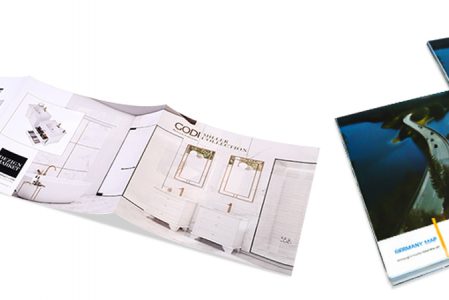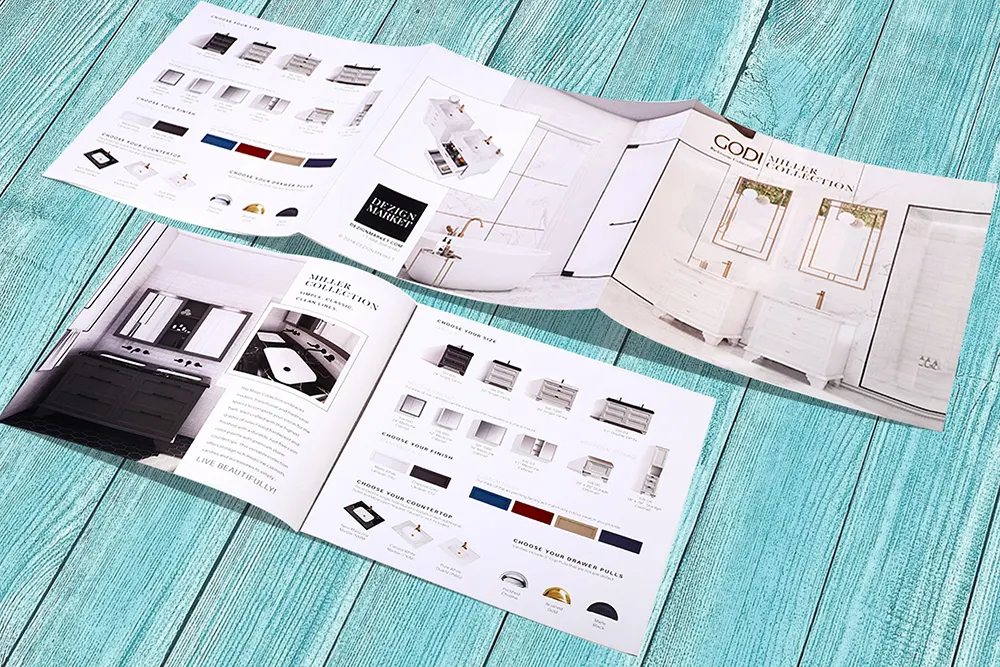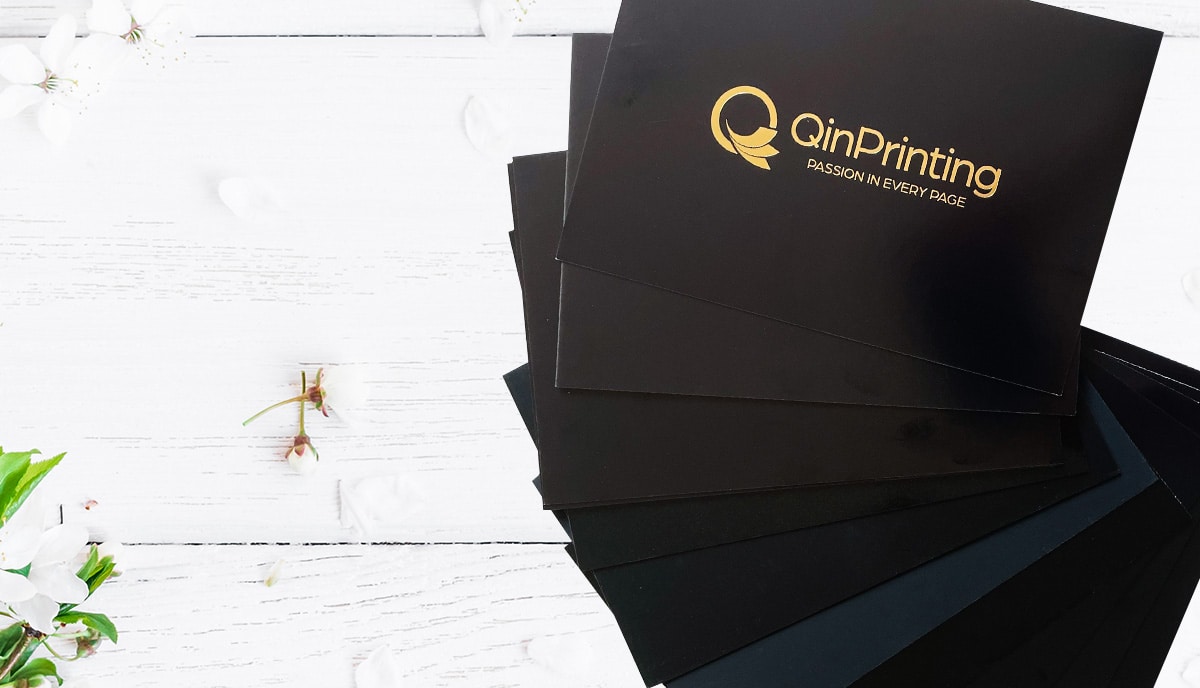Most businesses, large and small, recognize the continued importance of print marketing. We dive into the why, what, and how of running a successful print marketing campaign.

Print marketing has been around for centuries, and it remains one of the most powerful and effective marketing strategies available. As digital marketing continues to evolve, print marketing is still a great way to reach potential customers in a more tangible way. From brochures to flyers, print marketing can help you reach a larger audience and drive more sales. In this blog, we'll explore the top five types of print marketing, the benefits of print marketing, and ways to measure the success of your print marketing campaigns.
What is print marketing?
Print marketing is a form of advertising that uses physical printed materials to promote a product or service. This type of marketing can include brochures, flyers, posters, magazines, catalogs, and other printed materials. While digital marketing has become more popular in recent years, print marketing is still an effective tool for reaching potential customers. There are a few key benefits of print marketing that make it a great choice for businesses.
Benefits of print marketing
One of the biggest benefits of print marketing is that it is tangible. When a customer receives a printed flyer or brochure in the mail, they can hold it in their hands and get a better sense of the product or service being offered. It also feels more personal and direct. This makes it easier for customers to connect with the business, as they are able to physically interact with the print material.
Another advantage of print marketing is that it is cost-effective. Compared to digital marketing—which is a long-term, expensive strategy when you factor in web hosting, content creation, digital advertising, social media campaigning, and more—print marketing is relatively inexpensive and can reach a larger audience. Print marketing is also more targeted, as businesses can distribute to specific demographics or geographic areas with their printed materials.
Finally, print marketing is more memorable. Consumers are bombarded with digital ads on a daily basis, making it hard for them to remember the messages in those ads. People often talk about “digital overload” these days. They don't even see the ads, or they click away. Print marketing, on the other hand, is more likely to be remembered, as customers often find it less intrusive and are more likely to keep printed materials for reference.
Print marketing statistics
Print marketing is still a popular and effective marketing strategy. According to a survey by the Brand Chain (formerly, the PSDA), nearly 80% of consumers prefer to receive marketing materials in print. In addition, nearly 70% of consumers say they are more likely to remember a message if it is printed.
Furthermore, a survey by the Direct Marketing Association (DMA) found that direct mail has a 4.4% response rate, which is higher than any other type of media. This suggests that print marketing can be a great way to engage customers and generate leads.
Print marketing strategy
Before you start creating print marketing materials, it is important to have a clear strategy in place. The first step is to define your target audience. Who are you trying to reach with your printed materials? Are they male or female, young or old, or do they belong to a certain demographic or geographic area? Once you know who your target audience is, you can create tailored content that appeals to them.
The next step is to decide which type of printed materials you want to use. There are several types of print marketing, including brochures, flyers, magazines, catalogs, and more. Each type of material has its own benefits and drawbacks, so it is important to choose the one that best fits your needs.
Finally, you need to create a budget for your print marketing campaign. Print marketing can give great returns on your investment, but it's still important to set a realistic budget that you can stick to. Once you have a budget in place, you can start creating your print marketing materials.
Types of print marketing
Now that you know the basics of print marketing, let's take a look at the top five types of print marketing materials.
Brochure marketing
Brochure marketing is one of the most popular types of print marketing. Brochures are small printed materials that are usually 4 pages long and are used to provide more detailed information about a business or product. Brochures can be printed in full color or black and white, and they can come in a variety of shapes and sizes.
The main advantage of brochure marketing is that it is highly targeted. You can create tailored brochures that appeal to specific demographics or target specific geographic areas very easily and either mail them to your prospective customers or display them in place where they are likely to see them and pick them up. Brochures are also cost-effective, as they can be printed and shipped in bulk and distributed with a direct mail service provider.
Leaflet marketing
Leaflet marketing is another popular type of print marketing. Leaflets are similar to brochures, but they are usually smaller and come in a variety of shapes and sizes. Leaflets can be used to provide detailed information about a product or service and can be distributed in a variety of ways, including through direct mail, at events, or in the street.
Leaflet marketing is a great way to reach potential customers in a more personal way. Leaflets are may be printed in full color or black-and-white and can be tailored to specific sales, promotions, and campaigns.
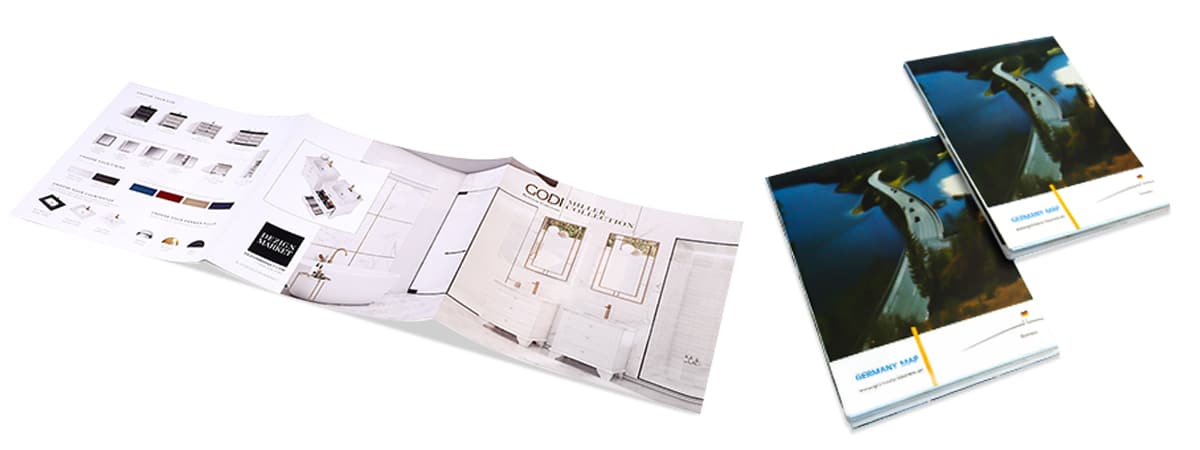
Resource: QinPrinting
Magazine marketing
Magazine marketing is a great way to reach potential customers in a way which combines the appeal of offline, printed materials with the power of content marketing to build a brand, tell a story, and draw leads into the sales funnel. Magazines are usually printed in full color on gloss coated paper and are used to provide detailed information about a product or service along with news, insights, opinion pieces, reviews, and even humor. Magazines are usually printed on a quarterly or monthly basis and can be distributed in a variety of ways, including through direct mail, through newsstands, at corporate events, or they can be ordered online via your company website.
Print catalog marketing
Print catalog marketing is a great way to reach potential customers in a more comprehensive way while making direct sales. Catalogs are a great way to engage customers, encourage repeat buying and brand loyalty, and can be designed to promote a one-off sale or new product line or to be comprehensive product directories running into thousands of pages.
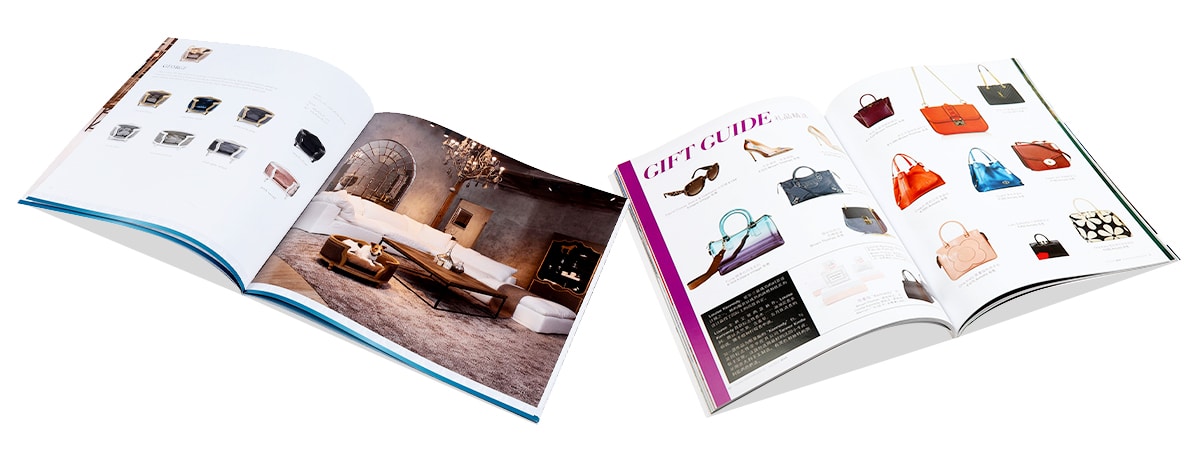
Resource: QinPrinting
Flyer marketing
Flyer marketing is a great way to reach potential customers in a cost-effective way. Flyers are usually single pages, often with a brief, one-point message and a call to action. They're excellent for awareness-raising campaigns, time-limited offers and sales, or to promote near-future events and bricks-and-mortar premises within a given locality.
Tips for creating effective print marketing materials
Now that you know the main different types of print marketing materials, let's take a look at some tips for creating effective materials.
- Keep it simple. Print materials should be easy to read and understand, so avoid using too much text or complicated graphics. Try to keep the design of the material simple but eye-catching.
- Use high-quality materials. Print materials should be printed on high-quality paper with vibrant colors to make them stand out. This will help to ensure that your marketing looks professional and makes a lasting impression on potential customers.
- Include a call to action (CTA). You should include a clear call to action on your printed materials, such as “Call now for a free consultation” or “Visit our website to learn more.” This will encourage potential customers to take the next step and contact your business.
Strategies for promoting your business with printed marketing materials
But you'll need to do more than just design and print your marketing materials, so let's take a look at some strategies for promoting your business in print.
- Distribute your materials in the right places. You should distribute your print materials in areas where your target audience is likely to be, such as local businesses, schools, shopping malls, tourist attractions, or events. You should also consider distributing your materials through direct mail, as this can be a great way to reach a more targeted audience or to engage a demographic that is geographically distant from your offices or store.
- Use print materials as part of a larger marketing campaign. You should use print materials in combination with other types of marketing, such as digital marketing, to reach a larger audience and drive more sales. Add QR codes to your print marketing to create a seamless link with your online campaigns.
- Offer incentives. You should consider offering incentives to encourage potential customers to take action, such as discounts or free products. This will help to encourage customers to keep your magazine, brochure, leaflet, flyer, or catalog and to contact your business and make a purchase.
Tips for optimizing your print marketing campaigns
Once you have created your print materials and developed a strategy for promoting your business, it is important to optimize your campaigns to ensure that they are successful. Here are some tips for optimizing your print marketing campaigns.
- Log your results. You should track how many people receive your print materials, how many people take action, and what kind of response you are getting. This will help you to understand what type of print materials are most effective and which areas need improvement. You can make tracking print materials easy with codes, QR, and an encouraging call-to-action.
- Use data to refine your campaigns. You should use data to identify trends and refine your campaigns to ensure that they are reaching the right people. You should also use data to track the effectiveness of your campaigns in terms of revenue return, email subscriber growth, or other metric on which the campaign focuses; and make changes as needed.
- Use A/B testing. A/B testing is a great way to test different versions of your print materials to see which one is most effective. This will help you to optimize your campaigns in the future and ensure that you are reaching the right people with the right message.
Measuring results of your print marketing campaigns
Once you have launched your print marketing campaigns, it is important to measure the results to ensure that they are successful. Here are some tips for measuring the results of your print marketing campaigns.
- Calculate your return on investment (ROI). You should track how much money you are spending on your print marketing campaigns and how much money you are making from them. This will help you to understand the effectiveness of your campaigns and help deliver the focus for future campaigns or changes in direction.
- Monitor the engagement rate. You should track how many people are engaging with your print materials, such as how many people are reading your brochures or responding to your flyers.
- Track customer feedback. You should track customer feedback to understand how your print materials are being received and make changes as needed. This will help you to optimize your campaigns and ensure that they are reaching the right people.
Talk to us!
At QinPrinting, we've been helping businesses just like yours to develop and print effective marketing materials for over 25 years. Our list of repeat-buying clients—many of whom have held active accounts with us for over a decade—are testimony to the effectiveness of our high-quality print products and the quality of our customer service. Get in touch today to discuss your print marketing needs and request a competitive, no-obligation quote. We can't wait to help your next campaign be the best yet. Let's talk!





